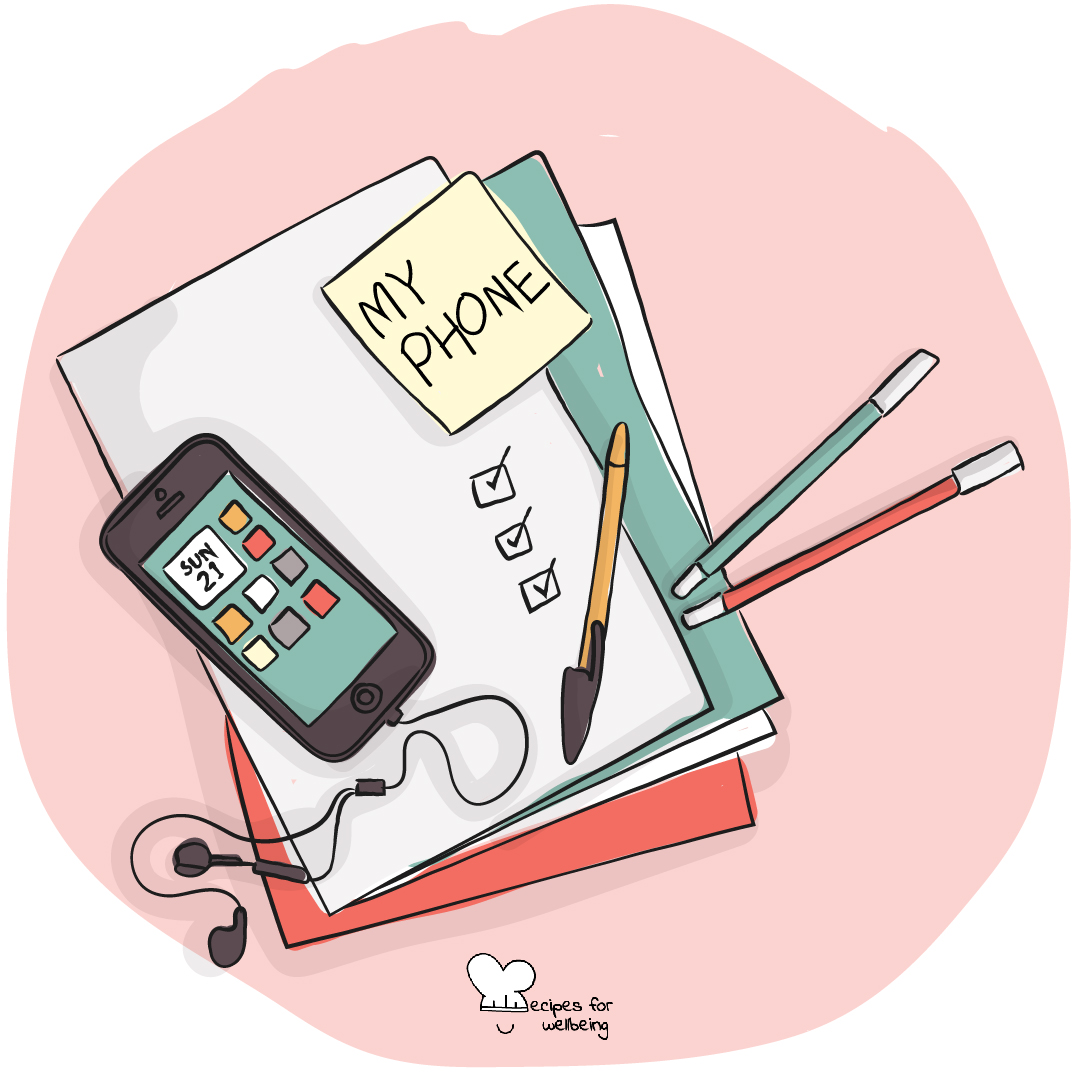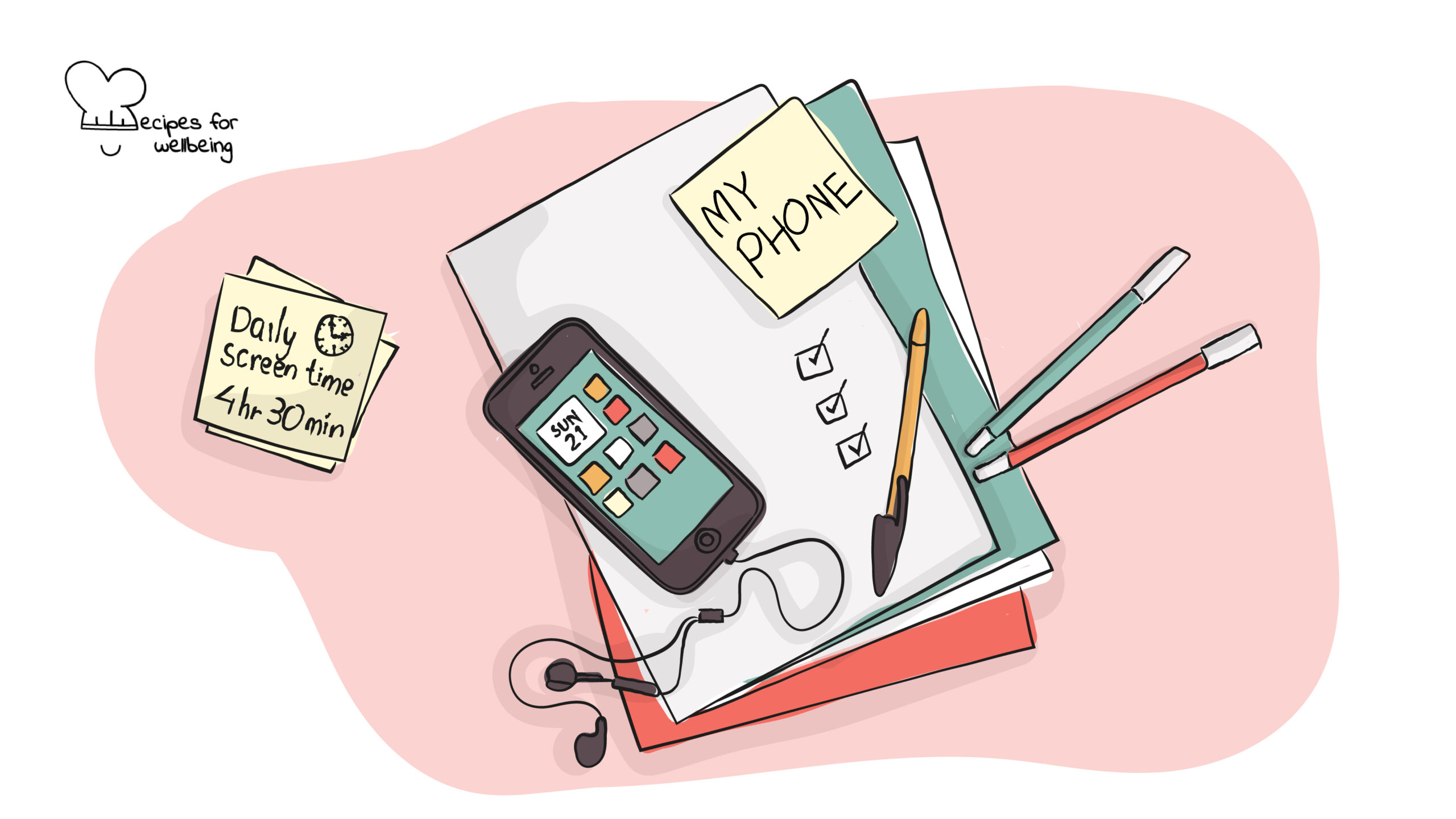
Building a conscious relationship with your phone
If something is a tool, it genuinely is just sitting there, waiting patiently. If something is not a tool it’s demanding things from you. It’s seducing you, it’s manipulating you, it wants things from you. We’ve moved away from a tools based technology environment, to an addiction and manipulation used technology environment. Social media isn’t a tool waiting to be used. It has its own goals, and it has its own means of pursuing them by using your psychology against you. ―Tristan Harris
👥 Serves: 1 person
🎚 Difficulty: Easy
⏳ Total time: 61-120 minutes
🥣 Ingredients: Your smartphone, your journal (or a sheet of paper), pens/coloured markers, a quiet space without distractions
🤓 Wholebeing Domains: Awareness, Digital Consciousness
💪 Wholebeing Skills: Balance, Digital agency, Digital boundaries, Digital discernment, Digital disconnection, Digital relating, Self-awareness

Building a conscious relationship with your phone
📝 Description
A reflective practice to foster a more conscious relationship with your smartphone.
Nowadays, we use our smartphones for a gazillion reasons – from work to personal matters, from productive to addictive patterns, from life-affirming, creative activities to mentally and emotionally challenging behaviours. Whether we like it or not, how we define our relationship with our phone ends up defining how we live our (daily) lives. This is an invitation to step into a more conscious relationship with your phone and to see it as a relationship in the first place. Consider it like your first couple’s therapy session, meant to help your relationship thrive and get healthier and healthier with every mindful step you take. This recipe has been kindly donated by our changemaker friend Corina Angelescu.
👣 Steps
Step 1 – Acknowledge your current relationship with your phone (20’)
Whether you’ve been using the same phone for years or just bought a new one, stop for a moment to reflect on your existing relationship with this device. When, how, why are you using your phone? Do you ever have the feeling that your phone is also using you? What behaviours and patterns stand out in your relationship?
Capture your reflections in the way you prefer (e.g. journaling, mind-mapping, drawing, etc.). Here are a few prompts to get you started:
- If my phone was a person, their personality would be…
- Our current relationship status is…
- My average daily screen time is…*
- The top 5 activities I use my phone for are…
- The top 3 reasons why I use my phone are…
- Examples of productive behaviours in our relationship are…
- Examples of addictive behaviours in our relationship are…
- From 0% to 100%, how much am I using my time in a conscious/mindful way?
*Most smartphones now calculate your average daily and weekly screen time in the settings, so check it out as we tend to underestimate our phone usage by 50%!
Step 2 – Set an intention (10’)
After exploring your current reality, focus your attention on your desired relationship with your phone. Imagine that from this very second, you have the opportunity to develop a more conscious relationship with it. What are you longing for in this dynamic? How can you spend more quality time together? What becomes possible if you develop a balanced connection?
Take your time to observe your needs from this relationship and try to capture them as an intention statement, so that you can go back to it whenever you need a reminder. An intention statement increases accountability, helps you understand yourself on a deeper level, and reinforces your belief in your own potential.
Examples:
- “My relationship with my phone is here to keep me connected with the people I love and to enable my creativity and growth.”
- “I am willing to step into a balanced relationship with my phone, one in which I take meaningful and relevant actions, I nurture my wellbeing consciously, and I learn how to set limits.”
Step 3 – Define guiding principles (10’)
Now it’s time to walk the talk! What are some guiding principles that can help you embody your intention every day? What are the core values or principles you’d like to honour to have a thriving relationship? What are the healthy boundaries you need? What is the nature of your work together?
Write down your top 5 guiding principles. If you want to be more efficient, try to phrase them in a way which makes them memorable.
Examples:
- Practice JOMO (the Joy Of Missing Out) vs FOMO (the Fear Of Missing Out).
- Scroll slowly. Tap slowly. Swipe slowly.
- When in doubt, go within, not on screen.
Step 4 – Clarify DOs and DON’Ts (30’)
Since we’re using our phones on a daily, even hourly basis, getting practical is essential. What changes do you actually need to make? Clarify your DOs and DON’Ts when it comes to:
- Social media platforms
- Messaging and (video) calls
- Pictures and videos
- Entertainment: music, movies, games…
- Work-related apps
- Your health and wellbeing as an user
If you struggle to make decisions, you can consider the Start – Stop – Continue framework for each of the aforementioned areas:
- Start: What are the new habits or actions that I need to implement in order to address my needs and have a healthier relationship with my phone?
- Stop: What are the things that keep me from having a healthy relationship with my phone that I need to stop doing or minimise?
- Continue: What are the practices which have proven to be effective and that I want to continue doing/using?
Step 5 – Personalise your phone
Finally, it’s time to unlock your phone and start implementing the changes you wish for. Consider:
- Updating your settings in a way that helps you walk the talk (e.g. schedule time away from the screen, silence notifications, read the T&Cs, check your storage options, etc.);
- Uninstalling apps which no longer serve your needs or wellbeing and organise remaining apps in folders or menus that make your phone feel clean and spacious (if you’re looking for inspiration on apps to boost your creativity and wellbeing, check out our recipe “Digital goodies”); and
- Making your phone aesthetically pleasing (e.g. use a new wallpaper which reflects the spirit of this new beginning).
And speaking of personalisation, you might even consider giving your phone a name to make your connection feel more alive. JOMO might be a good name to start with!

